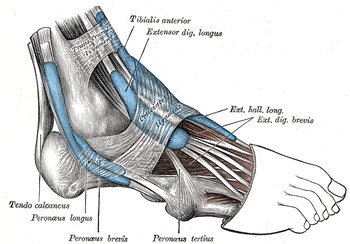
Plantarflexion
Encyclopedia


Tibia
The tibia , shinbone, or shankbone is the larger and stronger of the two bones in the leg below the knee in vertebrates , and connects the knee with the ankle bones....
, as when depressing an automobile pedal
Automobile pedal
An automobile may have two to four foot pedals. The arrangement is the same for both right- and left-hand traffic. From left to right:* normally operated by the left foot:**clutch pedal, not in the case of automatic transmission...
. The word "plantar" is commonly understood in medical terminology as the bottom of the foot - it translates as "toward the sole".
The movement in the opposite direction is dorsiflexion
Dorsiflexion
Dorsiflexion is the movement which decreases the angle between the dorsum of the foot and the leg, so that the toes are brought closer to the shin. The movement moving in opposite directions is called plantarflexion...
, where the dorsal part (top) of the foot is moved in a manner towards the tibia
Tibia
The tibia , shinbone, or shankbone is the larger and stronger of the two bones in the leg below the knee in vertebrates , and connects the knee with the ankle bones....
.
It occurs at the ankle
Ankle
The ankle joint is formed where the foot and the leg meet. The ankle, or talocrural joint, is a synovial hinge joint that connects the distal ends of the tibia and fibula in the lower limb with the proximal end of the talus bone in the foot...
.
The range of motion for plantar flexion is usually indicated in the literature as 30° to 40°, but sometimes also 50°.
The nerves are primarily from the sacral
Sacral nerves
The five sacral nerves emerge from the sacrum. Although the vertebral components of the sacrum are fused into a single bone, the sacral vertebrae are still used to number the sacral nerves....
spinal cord roots S1 and S2. Compression of S1 roots may result in weakness in plantar flexion.
Muscles
Primary muscles for plantar flexion are:- Posterior compartment of legPosterior compartment of legThe posterior compartment of the leg is supplied by the tibial nerve.It contains the plantar flexors:* deep: popliteus, flexor hallucis longus, flexor digitorum longus, tibialis posterior* superficial/calf: gastrocnemius, soleus, plantaris...
- superficial
- gastrocnemius
- soleus
- plantaris (only weak participation)
- deep
- flexor hallucis longus
- flexor digitorum longus
- tibialis posterior
- superficial
- Lateral compartment of legLateral compartment of legThe lateral compartment of the leg is supplied by the superficial fibular nerve.Its proximal and distal arterial supply consists of perforating branches of the anterior tibial artery and fibular artery....
(only weak participation)- peronaeus longus
- peronaeus brevis

